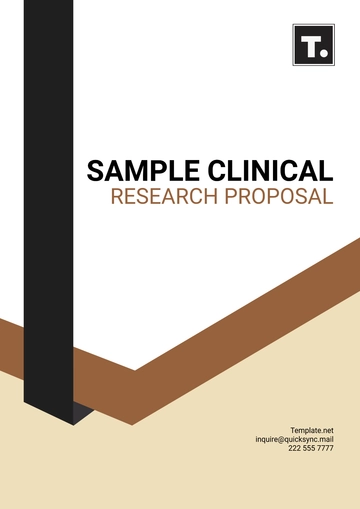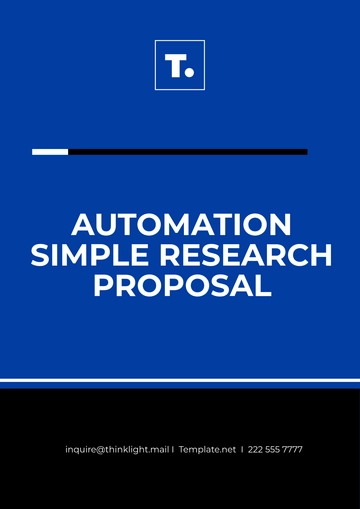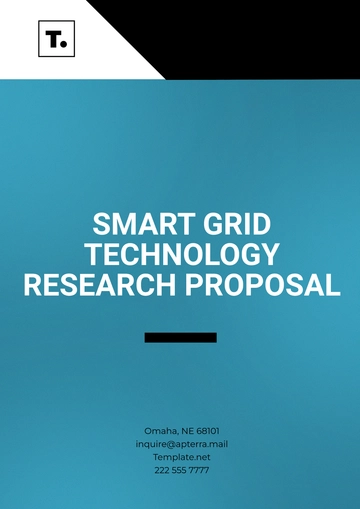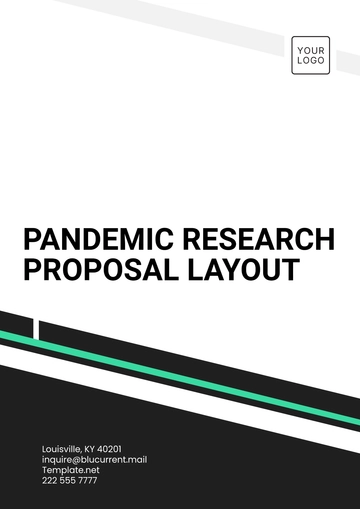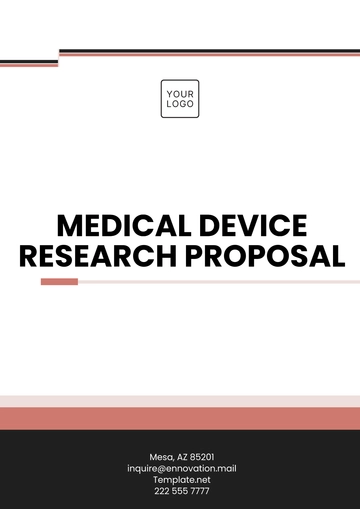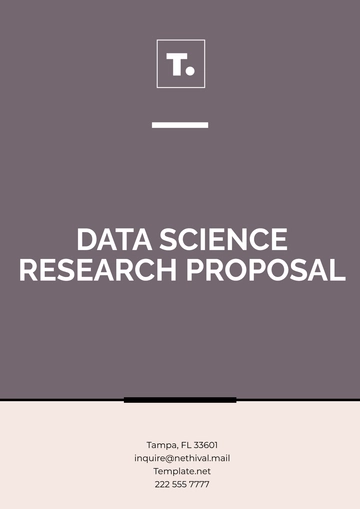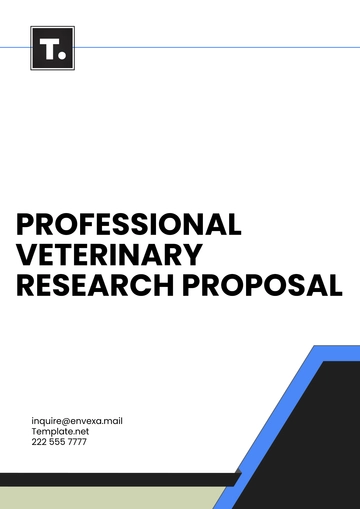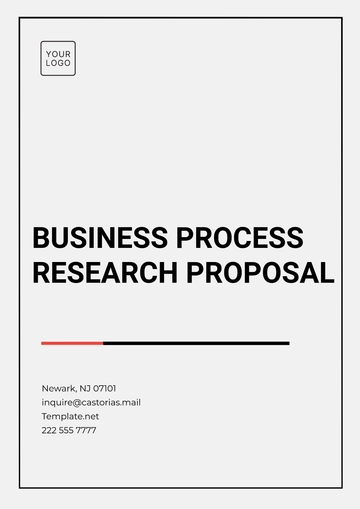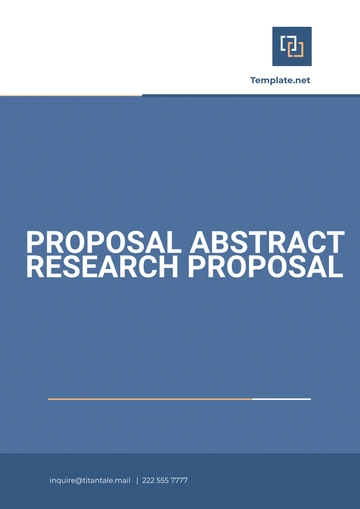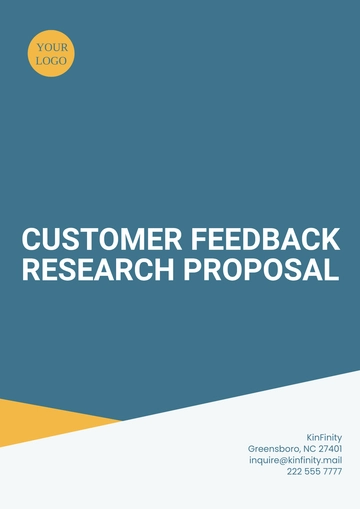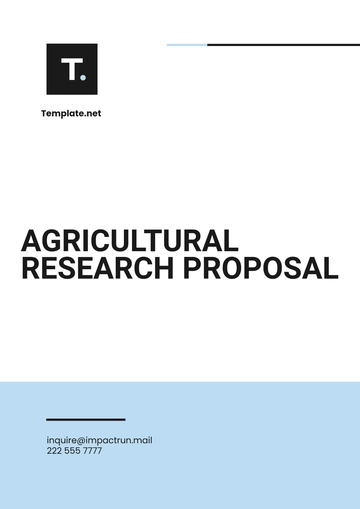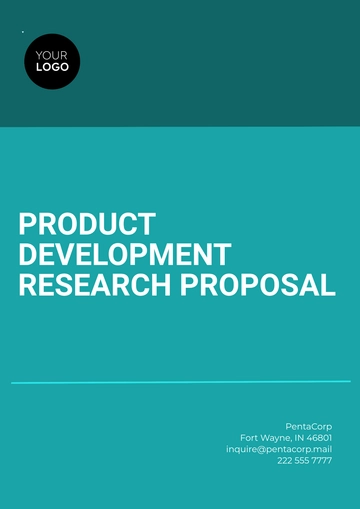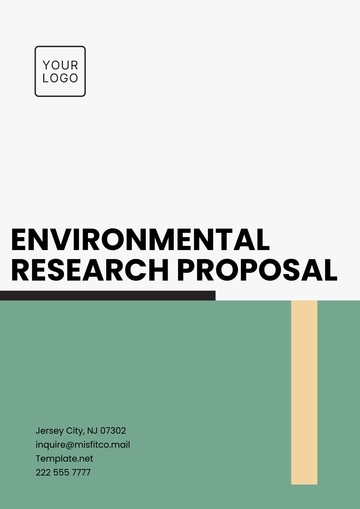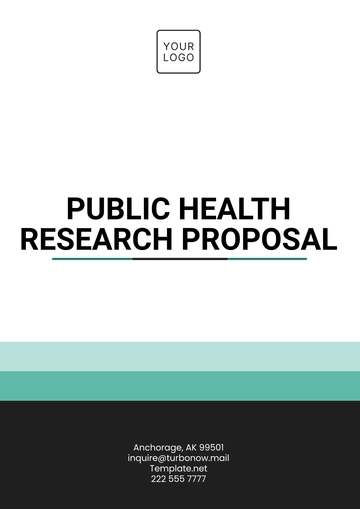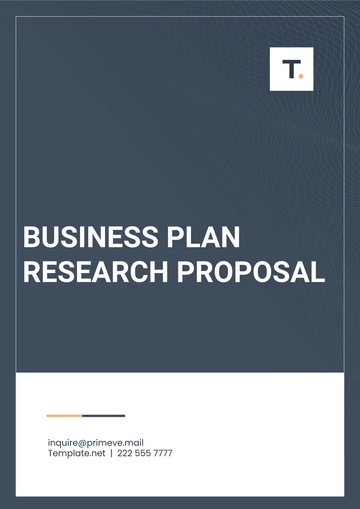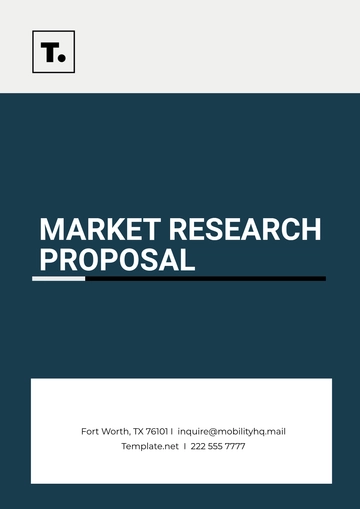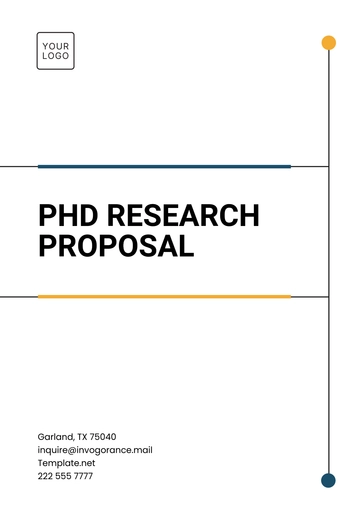Free Strategic Market Research Proposal
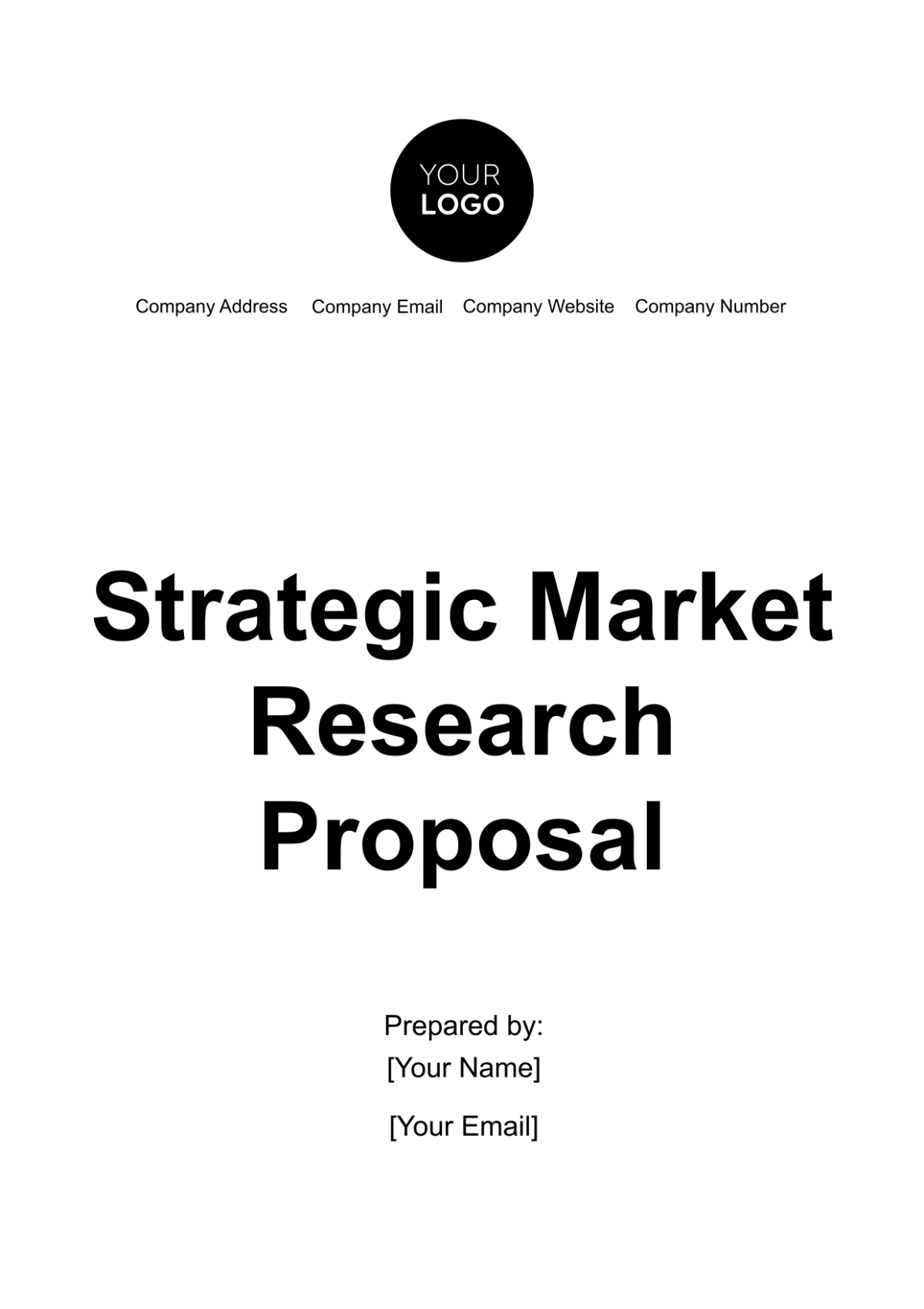
1. Executive Summary
1.1. Purpose of the Proposal
The purpose of this Strategic Market Research Proposal is to outline a comprehensive plan for conducting market research to support [Your Company Name]'s strategic business objectives well into the year 2070 and beyond. This proposal aims to provide a thorough overview of the research methods, timelines, and budget necessary to gain valuable insights into market trends, consumer behavior, and competitive dynamics in a rapidly evolving market landscape. The research will help [Your Company Name] adapt to future market conditions and capitalize on long-term opportunities.
1.2. Key Objectives
The primary objectives of this market research are:
To identify and analyze key market trends and dynamics that are expected to shape the industry up to the year 2070.
To understand evolving consumer preferences, behaviors, and purchasing patterns in the context of future technological and societal changes.
To evaluate the competitive landscape, including potential new entrants and disruptive innovations.
To assess potential market opportunities and threats that could emerge in the next few decades.
To provide actionable recommendations that support long-term strategic planning and decision-making for sustainable growth.
1.3. Scope of Research
The research will encompass various aspects of the market, including:
Market size, growth projections, and potential shifts in market dynamics up to 2070.
Analysis of consumer segmentation, demographics, and psychographic profiles as they evolve over time.
Competitive analysis, including emerging competitors, technological advancements, and regulatory changes.
Industry trends and emerging opportunities influenced by future developments.
Identification of potential barriers and challenges to market entry, including long-term environmental and economic factors.
1.4. Methodology Overview
The research will employ a mixed-methods approach combining qualitative and quantitative methods to ensure a robust analysis of future market conditions. Qualitative methods will include in-depth interviews and focus groups with industry experts, stakeholders, and consumers, while quantitative methods will involve surveys and market segmentation analysis. This comprehensive approach will provide a well-rounded understanding of the market and consumer insights.
1.5. Expected Outcomes
The expected outcomes of this research include:
Detailed market analysis reports that highlight key trends, opportunities, and challenges up to 2070.
Comprehensive consumer profiles and behavior insights reflecting future changes in preferences and values.
Competitive landscape analysis identifying key players, potential disruptors, and strategic positioning recommendations.
Strategic recommendations to support [Your Company Name]'s long-term planning, product development, and market expansion efforts.
1.6. Strategic Impact
The research findings will enable [Your Company Name] to make informed decisions about future market strategies, product development, and competitive positioning. Insights gained from the research will support strategic planning, helping [Your Company Name] to adapt to future market conditions, seize emerging opportunities, and maintain a competitive edge well into the year 2070 and beyond.
2. Introduction
2.1. Company Background
[Your Company Name] is a leading provider of innovative healthcare technology solutions, with a strong track record of delivering high-quality medical devices and health management systems since its inception in 2050. Our company specializes in developing advanced diagnostic equipment, wearable health monitors, and integrated health management software designed to enhance patient care and streamline healthcare delivery.
[Your Company Name] is committed to innovation, customer satisfaction, and sustainability. Our mission is to "Revolutionize healthcare through cutting-edge technology that empowers both patients and healthcare providers, while promoting environmental stewardship." We achieve this mission by continuously advancing our product offerings, investing in research and development, and staying attuned to the evolving needs of the healthcare industry.
As we look towards the future, including the year 2070, our goal is to ensure that [Your Company Name] remains at the forefront of the healthcare technology sector. We aim to achieve this by:
Anticipating Future Needs: Identifying and addressing emerging trends and challenges in healthcare technology to maintain our competitive edge.
Innovating Continuously: Developing new and improved products that leverage the latest advancements in technology and medical research.
Fostering Sustainability: Implementing eco-friendly practices and designing products that contribute to a more sustainable healthcare ecosystem.
Enhancing Customer Experience: Providing exceptional support and service to meet the needs of our customers and improve patient outcomes.
2.2. Industry Overview
The healthcare technology industry is characterized by rapid technological advancements, shifting consumer preferences, and evolving regulatory landscapes. Key trends impacting the industry include:
Digital Transformation: The integration of digital technologies into healthcare practices, such as telemedicine, electronic health records (EHRs), and data analytics, is transforming how healthcare services are delivered and managed.
Sustainability Initiatives: There is an increasing focus on environmental sustainability within the healthcare sector, including the development of eco-friendly medical devices and energy-efficient healthcare facilities.
Personalized Medicine: Advances in genomics and biotechnology are enabling more personalized and targeted treatment options, improving patient outcomes and reducing healthcare costs.
Aging Population: The growing number of elderly individuals is driving demand for healthcare technologies that support chronic disease management, remote monitoring, and improved quality of life.
As we approach 2050, the healthcare technology industry is expected to experience significant changes, including:
Advancements in Technology: Emerging technologies such as artificial intelligence, robotics, and advanced diagnostics will play a pivotal role in enhancing healthcare delivery and patient care.
New Market Entrants: The entry of innovative startups and technology companies will introduce new solutions and competition to the market, driving further advancements and innovation.
Shifts in Consumer Behavior: Increased patient engagement and demand for personalized healthcare solutions will influence the development and adoption of new technologies.
2.3. Market Context
The current market context includes various factors that will influence the industry in the coming decades. Economic conditions, technological innovations, social changes, and environmental concerns are shaping the market landscape. For instance, advancements in artificial intelligence, changes in global trade policies, and growing environmental awareness are expected to impact market dynamics. By considering these factors, [Your Company Name] can better anticipate future market trends and develop strategies to address emerging challenges and opportunities.
2.4. Need for Market Research
Market research is essential for:
Gaining a deeper understanding of future consumer needs and preferences as they evolve with technological and societal changes.
Identifying market gaps and opportunities that may arise in the coming decades.
Making data-driven decisions to mitigate risks associated with long-term planning and investments.
Enhancing competitive positioning and strategic planning to ensure sustained growth and adaptability.
2.5. Research Objectives
The research objectives are designed to address key questions and provide actionable insights:
What are the key drivers of market growth and disruption in the [industry] up to 2070?
How will consumer preferences and behaviors change over time, and what implications will this have for market strategies?
What is the competitive landscape likely to look like, and how can [Your Company Name] differentiate itself from emerging competitors?
What strategies can be employed to leverage future market opportunities and address potential challenges?
2.6. Research Questions
The research will seek to answer the following questions:
What are the expected trends and dynamics in the [industry] market through 2070?
How will consumer preferences and purchasing behaviors evolve in response to technological advancements and societal changes?
Who are the potential future competitors, and what are their likely strengths and weaknesses?
What strategies should [Your Company Name] consider to capitalize on emerging trends and navigate potential challenges?
3. Research Design and Methodology
3.1. Research Design Overview
The research design will integrate both qualitative and quantitative methods to ensure a comprehensive analysis of future market conditions. This approach will involve:
Developing a detailed research plan that outlines the objectives, methods, and timeline.
Designing research instruments that address both current and future market dynamics.
Implementing data collection and analysis procedures that provide robust and actionable insights.
3.2. Qualitative Research Methods
Qualitative research methods will provide in-depth insights into consumer attitudes, perceptions, and future expectations.
3.2.1. In-Depth Interviews
In-depth interviews will be conducted with industry experts, key stakeholders, and a representative sample of consumers. These interviews will explore:
Individual perspectives on emerging market trends and future consumer needs.
Detailed opinions on potential disruptors and innovations expected to impact the industry.
Personal experiences and expectations regarding future products, services, and market conditions.
3.2.2. Focus Groups
Focus groups will be organized to gather diverse viewpoints on market trends and consumer behavior. Each group will consist of 8-12 participants from different demographic and psychographic segments. Discussions will focus on:
Emerging trends and innovations expected to influence the industry by 2070.
Attitudes towards new technologies, products, and services.
Preferences for future product features and service improvements.
Anticipated changes in consumer behavior and purchasing decisions.
Focus groups will provide qualitative insights that complement the quantitative data, offering a deeper understanding of consumer expectations and market dynamics.
3.3. Quantitative Research Methods
Quantitative research methods will involve structured data collection and analysis to provide statistical insights and validate qualitative findings.
3.3.1. Surveys
Surveys will be designed to collect data from a large sample of respondents. Key elements of the survey will include:
Questions on consumer preferences, purchasing behavior, and attitudes towards future market developments.
Demographic and psychographic questions to segment the market and identify target audiences.
Scaled questions to measure the importance of various factors influencing future decisions.
Surveys will be distributed through online platforms and mobile applications to ensure a wide reach and high response rate. Data collected will be analyzed to identify trends, correlations, and patterns relevant to future market conditions.
3.3.2. Market Segmentation Analysis
Market segmentation analysis will categorize consumers into distinct groups based on their preferences, behaviors, and demographics. This analysis will:
Identify key segments likely to drive market growth and change by 2070.
Assess the potential size and value of each segment.
Provide insights into segment-specific needs and preferences, guiding targeted marketing strategies.
The analysis will use statistical techniques to segment the market and project future trends for each segment.
3.4. Data Collection Techniques
3.4.1. Primary Data Collection
Primary data will be collected directly from respondents through:
Surveys: Distributed via online platforms and mobile applications.
Interviews: Conducted in-person, over the phone, or via video conferencing.
Focus Groups: Held in various locations with targeted participant groups.
Primary data collection will ensure that the information gathered is current, relevant, and specific to the research objectives.
3.4.2. Secondary Data Collection
Secondary data will be sourced from existing reports, studies, and industry publications. This includes:
Industry reports and market studies from reputable sources.
Academic research papers and white papers on market trends and consumer behavior.
Government publications and statistical data relevant to the industry.
Secondary data will provide context and background information, helping to validate and supplement the primary data collected.
3.5. Sampling Strategy
The sampling strategy will ensure that the research results are representative and reliable. Key components include:
Defining the target population based on demographic, geographic, and psychographic criteria.
Selecting a sample size that provides statistical significance and accuracy.
Using random and stratified sampling techniques to ensure a representative sample.
The sampling strategy will account for future market changes and ensure that the data collected is applicable to long-term planning.
3.6. Data Analysis Plan
Data analysis will involve several stages:
Data Cleaning: Ensuring accuracy and consistency by removing errors and inconsistencies.
Statistical Analysis: Using statistical methods to identify trends, correlations, and patterns.
Comparative Analysis: Comparing qualitative insights with quantitative data to draw comprehensive conclusions.
Forecasting: Projecting future market conditions based on current and historical data.
The analysis will be conducted using advanced data analysis tools and software to ensure precision and reliability.
3.7. Tools and Software
The following tools and software will be utilized for data collection and analysis:
Survey Platforms: Platforms such as SurveyMonkey and Qualtrics will be used for designing and distributing surveys.
Data Analysis Software: SPSS, Tableau, and other statistical software will be employed for data analysis and visualization.
Communication Tools: Zoom, Microsoft Teams, and other virtual meeting platforms will facilitate interviews and focus groups.
4. Project Plan and Timeline
4.1. Project Phases
4.1.1. Planning Phase
The Planning Phase will involve:
Defining Research Objectives and Scope: Establishing clear objectives and boundaries for the research.
Developing Research Design and Methodology: Designing the research plan, including methods and instruments.
Preparing Research Instruments: Creating and testing surveys, interview guides, and other tools.
Securing Necessary Approvals and Resources: Obtaining approvals from stakeholders and ensuring resources are in place.
The Planning Phase is critical for setting the foundation for successful research and ensuring that all aspects of the project are well-defined.
4.1.2. Execution Phase
The Execution Phase includes:
Conducting Data Collection Activities: Implementing surveys, interviews, and focus groups as per the research plan.
Monitoring Data Collection Progress: Tracking the progress and addressing any issues that arise.
Ensuring Data Quality and Integrity: Implementing quality control measures to maintain data accuracy and reliability.
This phase is crucial for gathering high-quality data and ensuring that the research objectives are met.
4.1.3. Reporting Phase
The Reporting Phase will involve:
Analyzing and Interpreting Data: Conducting a thorough analysis of the collected data and deriving insights.
Preparing Interim and Final Reports: Compiling and presenting findings in comprehensive reports.
Presenting Findings and Recommendations: Sharing results with stakeholders and providing actionable recommendations.
The Reporting Phase is essential for communicating the research outcomes and supporting strategic decision-making.
4.2. Key Milestones
Key milestones in the project include:
Completion of Research Design and Methodology: Finalizing the research plan and methods.
Finalization of Data Collection Instruments: Completing and testing surveys and interview guides.
Completion of Data Collection and Initial Analysis: Gathering and analyzing data, with preliminary results available.
Delivery of Interim and Final Reports: Providing detailed reports and presentations to stakeholders.
4.3. Timeline and Deadlines
The project timeline is as follows:
Planning Phase: January 8, 2070 to February 23, 2070 (Duration: 7 weeks)
This phase includes initial research design and planning activities. Key tasks during this period will involve defining research objectives, developing methodologies, and preparing for the data collection process.
Execution Phase: February 26, 2070 to April 12, 2070 (Duration: 6 weeks)
This phase focuses on data collection and monitoring. Activities will include conducting surveys, interviews, or experiments, and gathering relevant data as per the research design.
Reporting Phase: April 15, 2070 to May 24, 2070 (Duration: 6 weeks)
This phase includes data analysis, report preparation, and presentation. Key tasks will involve analyzing the collected data, preparing comprehensive reports, and presenting findings to stakeholders.
4.4. Resource Allocation
Resource allocation will include:
Assigning Team Members: Designating roles and responsibilities for project team members.
Ensuring Availability of Tools and Technology: Providing necessary tools and technology for data collection and analysis.
Budgeting for External Resources: Allocating budget for any external resources or vendors required for the project.
4.5. Risk Management
Potential risks and mitigation strategies include:
Data Collection Delays: Implementing contingency plans and adjusting timelines as needed.
Low Response Rates: Employing multiple data collection methods and follow-ups to increase response rates.
Data Quality Issues: Implementing strict data validation procedures and quality checks to ensure data integrity.
5. Budget and Resources
5.1. Budget Breakdown
5.1.1. Research Design Costs
Costs associated with designing the research include:
Development of Research Instruments: Costs for creating surveys, interview guides, and other tools.
Pilot Testing of Research Tools: Expenses related to testing and refining research instruments.
5.1.2. Data Collection Costs
Expenses related to data collection include:
Survey Distribution and Incentives: Costs for distributing surveys and providing incentives to participants.
Conducting Interviews and Focus Groups: Costs associated with organizing and facilitating interviews and focus groups.
5.1.3. Data Analysis Costs
Costs for analyzing the collected data include:
Software Licenses: Fees for data analysis software and tools.
Consultants or Data Analysts: Payments for external experts or consultants if required.
5.1.4. Reporting Costs
Expenses for preparing and presenting reports include:
Design and Printing of Reports: Costs for designing, printing, and distributing final reports.
Presentation Costs: Expenses related to presenting findings to stakeholders, including travel and materials.
5.2. Resource Requirements
5.2.1. Human Resources
Personnel required for the project include:
Project Manager: Responsible for overseeing the project, managing timelines, and ensuring deliverables are met.
Research Analysts: Conduct data collection, analysis, and reporting.
Data Entry Specialists: Handle data entry, validation, and quality control.
5.2.2. Technology and Tools
Technology and tools needed include:
Survey Platforms: Tools such as SurveyMonkey and Qualtrics for designing and distributing surveys.
Data Analysis Software: SPSS, Tableau, and other tools for data analysis and visualization.
Communication Tools: Platforms like Zoom and Microsoft Teams for conducting interviews and focus groups.
5.2.3. External Vendors
Potential external vendors may include:
Market Research Firms: For specialized expertise and additional resources.
Data Collection Agencies: For large-scale survey distribution and data collection.
5.3. Financial Justification
The budget is justified based on:
Complexity and Scope: The extensive nature of the research, including long-term projections and detailed analysis.
Need for High-Quality Data: The importance of obtaining accurate and reliable data for strategic decision-making.
Potential Strategic Value: The long-term benefits of gaining insights into future market conditions and opportunities.
6. Deliverables and Reporting
6.1. Interim Reports
Interim reports will provide updates on the progress of the research, including:
Preliminary Findings: Initial insights and trends identified during data collection.
Project Status: Updates on the completion of milestones and any issues encountered.
Next Steps: Planned activities and adjustments based on interim findings.
6.2. Final Report
The final report will include:
Comprehensive Analysis: Detailed findings from the research, including quantitative and qualitative insights.
Strategic Recommendations: Actionable recommendations based on the research findings.
Executive Summary: A summary of key findings and recommendations for quick reference by stakeholders.
6.3. Presentation of Findings
The presentation of findings will include:
Presentation Slides: Visuals and key points to communicate the research results effectively.
Q&A Session: An opportunity for stakeholders to ask questions and discuss the findings.
7. Conclusion
7.1. Summary of Objectives
The research aims to provide a comprehensive understanding of future market conditions, consumer behavior, and industry trends. The insights gained will support strategic decision-making and long-term planning.
7.2. Expected Outcomes
Expected outcomes include:
Detailed Market Insights: In-depth understanding of market trends, consumer preferences, and potential opportunities.
Strategic Recommendations: Practical recommendations for positioning the company effectively in the future market.
7.3. Implications for Future Planning
The research will inform future strategic planning, including:
Product Development: Identifying opportunities for innovation and development.
Marketing Strategies: Tailoring marketing strategies to align with future consumer preferences and market conditions.
Investment Decisions: Guiding investment decisions based on anticipated market changes and growth opportunities.
- 100% Customizable, free editor
- Access 1 Million+ Templates, photo’s & graphics
- Download or share as a template
- Click and replace photos, graphics, text, backgrounds
- Resize, crop, AI write & more
- Access advanced editor
Present your research strategy with the Strategic Market Research Proposal Template on Template.net. This editable and customizable template offers a professional format to outline your research objectives, methodology, and timeline. Use our Ai Editor Tool to tailor the proposal, ensuring it aligns with your client's or business's strategic goals.
You may also like
- Business Proposal
- Research Proposal
- Proposal Request
- Project Proposal
- Grant Proposal
- Photography Proposal
- Job Proposal
- Budget Proposal
- Marketing Proposal
- Branding Proposal
- Advertising Proposal
- Sales Proposal
- Startup Proposal
- Event Proposal
- Creative Proposal
- Restaurant Proposal
- Blank Proposal
- One Page Proposal
- Proposal Report
- IT Proposal
- Non Profit Proposal
- Training Proposal
- Construction Proposal
- School Proposal
- Cleaning Proposal
- Contract Proposal
- HR Proposal
- Travel Agency Proposal
- Small Business Proposal
- Investment Proposal
- Bid Proposal
- Retail Business Proposal
- Sponsorship Proposal
- Academic Proposal
- Partnership Proposal
- Work Proposal
- Agency Proposal
- University Proposal
- Accounting Proposal
- Real Estate Proposal
- Hotel Proposal
- Product Proposal
- Advertising Agency Proposal
- Development Proposal
- Loan Proposal
- Website Proposal
- Nursing Home Proposal
- Financial Proposal
- Salon Proposal
- Freelancer Proposal
- Funding Proposal
- Work from Home Proposal
- Company Proposal
- Consulting Proposal
- Educational Proposal
- Construction Bid Proposal
- Interior Design Proposal
- New Product Proposal
- Sports Proposal
- Corporate Proposal
- Food Proposal
- Property Proposal
- Maintenance Proposal
- Purchase Proposal
- Rental Proposal
- Recruitment Proposal
- Social Media Proposal
- Travel Proposal
- Trip Proposal
- Software Proposal
- Conference Proposal
- Graphic Design Proposal
- Law Firm Proposal
- Medical Proposal
- Music Proposal
- Pricing Proposal
- SEO Proposal
- Strategy Proposal
- Technical Proposal
- Coaching Proposal
- Ecommerce Proposal
- Fundraising Proposal
- Landscaping Proposal
- Charity Proposal
- Contractor Proposal
- Exhibition Proposal
- Art Proposal
- Mobile Proposal
- Equipment Proposal
- Student Proposal
- Engineering Proposal
- Business Proposal
